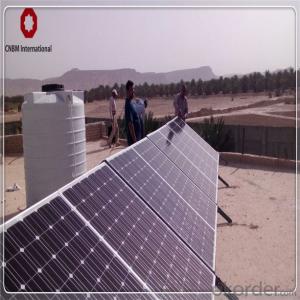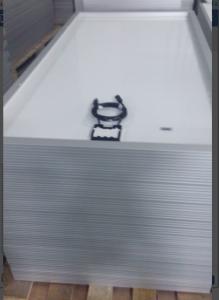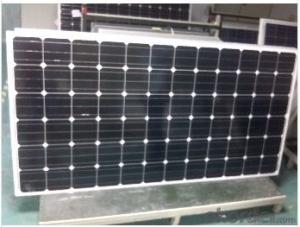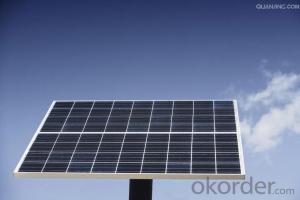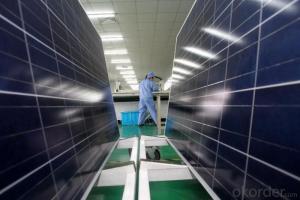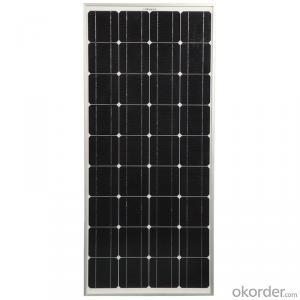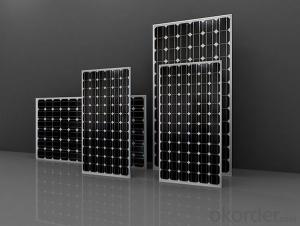Solar Panels on Standing Seam Metal Roof - Mono and Poly 5W to 320W Solar Panel CE/IEC/TUV/UL Certificate Non-Anti-Dumping
- Loading Port:
- China main port
- Payment Terms:
- TT OR LC
- Min Order Qty:
- 250 watt
- Supply Capability:
- 2500000 watt/month
OKorder Service Pledge
OKorder Financial Service
You Might Also Like
1.Detailed Information
Solar panel, is the most indispensable and valuable part of the solar power power system, plays a role to convert the sun radiation to electrical energy, to sent to the storage battery, or to promote the workloads.
2.Specifications:
| Related Maximum Power(Pmax) | 200W |
| Current at Pmax(Imp) | 5.45A |
| Voltage at Pmax(Vmp) | 36.7V |
| Short-Circuit Current(Isc) | 5.65A |
| Open-Circuit Voltage(Voc) | 45.4V |
| Module Dimension | 1580*808*35mm |
| Cel Type | 125*125mm Mono-crystalline |
| Cell configuration | 72 (6*12)PCS in series |
| Weight | 15kg |
| Cables | 4.0mm², Length: 900mm |
3.Technology

4.The picture of the products
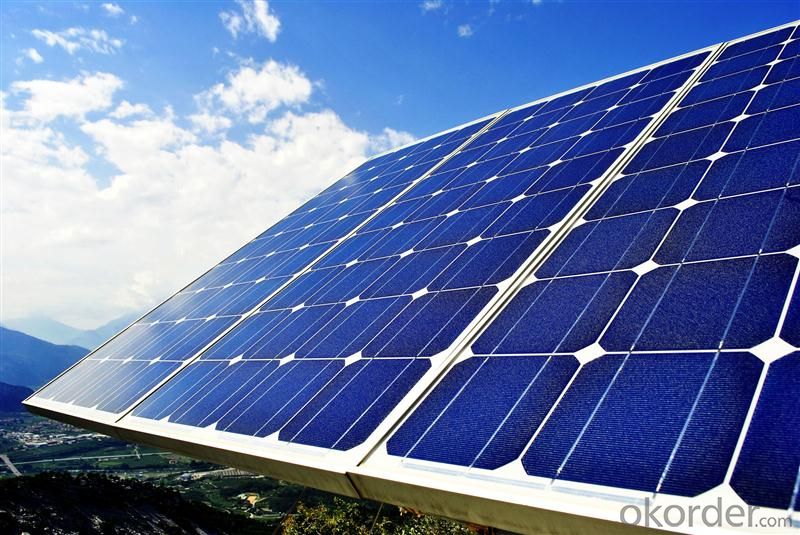
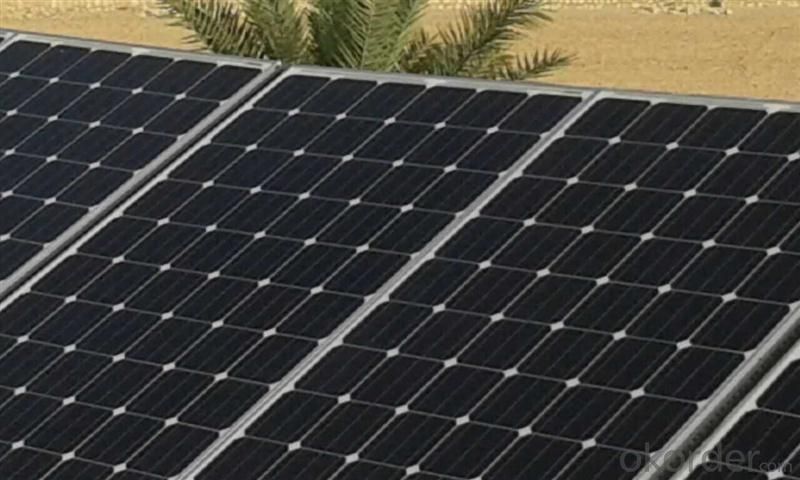
5.FAQ
1). Which payment terms can you accept?
T/T,L/C, l are available for us.
2).How to guarantee the Quality of the products?
We have established the international advanced Quality management
system,every link from raw material to final product we have strict
Quality test;We resolutely put an end to unqualified products flowing into the market. At the same time, we will provide necessary follow-upservice assurance.
3).How about your company?
CNBM Solar photovoltaic (PV) Panel has various wattage from 1.5W to 315W to meet the demand of every customer. It is the optimal choice for both on-grid and off-grid power systems. CNBM Solar panel offers high performance of power warranty and good after sale service, we have professional people to reply your problem anytime.
CNBM International Corporation's products including Monocrystalline Solar Panel, Polycrystalline Solar Panel have received and enjoyed famous reputation in many countries and regions in the world .As a solar panel supplier in China, we strive to provide our customers with excellent service, superior products and unmatched value.
4).How to guarantee the quality of the products?
CNBM Solar performance guarantees for 25 years
• 12 years guarantee for workmanship
• Timeliness of delivery
• Quality Products certified (TÜV, UL, CE, ISO)
- Q: Hello Yahoo, I am doing another one of my wacky inventions however I need something that will give me 2V of power!I don't want to connect loads of AA batteries into a battery holder as this shall run out quickly and become expensive in the long run, I don't want to carry around a big car battery either.I have been searching around on OKorder .uk and found some Solar-Powered 2V Trickle Chargers. These say they shall work on cloudy days (which is perfect as the majority of the time that is all we get!) but could I use it as an independent power source?If I attached the thing I want to run to the solar panel will it supply it with 2V of power?
- If you want to run something from a solar panel, you should remember that the power from the panel is only available when there is reasonable sunshine on the panel. Usually the solar panels are used with solar regulators in order to charge batteries. These batteries are used as energy storage for when the sun is not shining. Now, this does not mean that you cannot drive instruments directly from the solar panel and regulator. To do this, you will need a panel that has sufficient power to drive your instrument. An example is the solar powered garden or fountain pumps. I have driven 2V computer fans directly from the small solar panels - useful for cooling of things such as pool pump housings. The solar regulator is used to convert the solar panel output to a 3.5V output in order to charge lead acid batteries. I have used MPPT regulators (maximum power point tracking) which is more efficient than the standard solar regulator. If you don't use these regulators you may find the solar panel producing up to 7-9V in good sunshine which is not good for your instruments that are expecting 2-3V. Hence the answer to your question is that you will need to have a battery being charged to get useful power from the solar panels via a solar regulator.
- Q: Can solar panels be installed in areas with high humidity?
- Yes, solar panels can be installed in areas with high humidity. While humidity can slightly affect the efficiency of solar panels, it does not prevent their installation or operation. Modern solar panel technology is designed to withstand various environmental conditions, including high humidity, and they can still generate electricity even in humid environments.
- Q: My mom's house has some solar power panels on the top of her house but they are not connected to anything. They don't even have wires or anything like that. Does anyone know how to connect and make solar panels work? Thank You
- It sounds like you nor anyone at your home knows enough about solar to be able to hook them up no matter what type they are. I have to agree with others that they could be hooked up and you just can't see the connections. So the best thing for you to do is get a contractor to come out and check them out. It don't have to be a Solar Dealer because I am a dealer and I use electrical contractors to do the installs. A solar dealer is not always legal to install and normally do like I do and just design and sell the systems. However most any dealer can easly install a solar power system because they are trained just not legal to do the work. Having someone other then an electrician work on it could void the warranties.
- Q: Can solar panels be used to power outdoor lighting?
- Yes, solar panels can be used to power outdoor lighting. Solar panels convert sunlight into electricity, which can be stored in batteries or used directly to power outdoor lights such as garden lights, pathway lights, or streetlights. This allows for environmentally friendly and cost-effective lighting solutions in outdoor areas.
- Q: I need to know how do solar panels work. I need to know what are they made of.
- The term solar panel is best applied to a flat solar thermal collector, such as a solar hot water or air panel used to heat water, air, or otherwise collect solar thermal energy. But 'solar panel' may also refer to a photovoltaic module which is an assembly of solar cells used to generate electricity. In all cases, the panels are typically flat, and are available in various heights and widths.
- Q: I was thinking of having some installed on our rooftop and was wondering if it would be worth the cost? The house is located in Sac, Cali. The panels would face the sun 2 months out of the year and in the summer roughly 4 hours of straight sun.
- Solar is too expensive system. It is relatively new. Everything new is top dollar. When the market gets flooded the cost will dramatically go down as everything like cell phones, computers etc.
- Q: Can solar panels be installed on historical landmarks?
- Yes, solar panels can be installed on historical landmarks. However, it requires careful planning and consideration to ensure that the installation does not compromise the historical integrity of the landmark. This may involve using discreet mounting systems or integrating solar panels into existing structures. Additionally, obtaining the necessary permits and approvals from relevant authorities is crucial before proceeding with the installation.
- Q: How do solar panels affect the property taxes?
- Solar panels can potentially affect property taxes as they may increase the value of a property. However, the impact on property taxes varies depending on the location and local regulations. In some areas, installing solar panels may qualify homeowners for tax incentives or exemptions, while in others, it may lead to a slight increase in property tax assessments. It is advisable to consult with local authorities or a tax professional to understand the specific implications in a particular area.
- Q: I have seen quite a few different websites that talk about building your own solar panels for around $200. I wanted to know if anyone has had any experience with this before I decide to try it myself. It would be very helpful to know what I can expect from such an inexpensive setup; what kind of electronics or appliances would I be able to power. Realistically what can I expect from a $200 setup, and what would I need to power say a whole bedroom (clock, regular sized TV, PC, ext.).
- Scam. okorder / Many of the other review sites are fakes to steer people into buying.
- Q: Heard you can put solar panels on laptops Anyone know if it can work on a Dell mini 0v? I've seen he USB slot solar pana but can someone tell me where to gt these?
- If okorder /
Send your message to us
Solar Panels on Standing Seam Metal Roof - Mono and Poly 5W to 320W Solar Panel CE/IEC/TUV/UL Certificate Non-Anti-Dumping
- Loading Port:
- China main port
- Payment Terms:
- TT OR LC
- Min Order Qty:
- 250 watt
- Supply Capability:
- 2500000 watt/month
OKorder Service Pledge
OKorder Financial Service
Similar products
Hot products
Hot Searches
